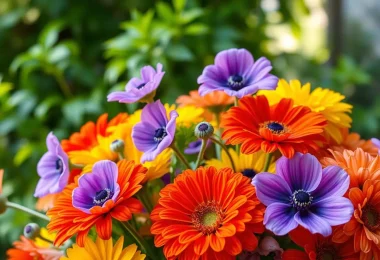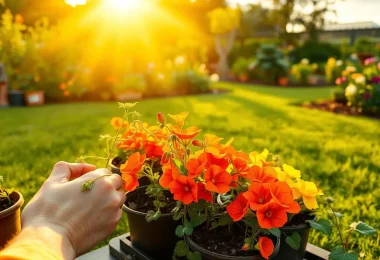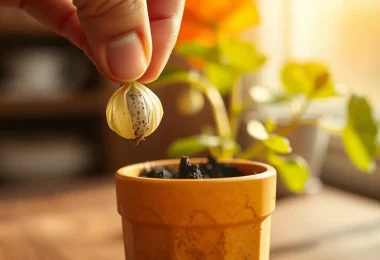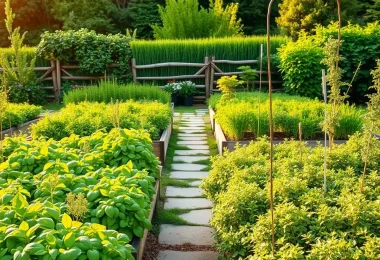Turning your garden into a beautiful and useful outdoor space is a fun task. Sleepers, or timber logs, are a popular choice for garden designs. They add beauty and function to your garden.
This article will show you how sleepers can be used in many ways. You can make raised beds, walls, paths, and edges with them. We’ll talk about the benefits, types, and how to prepare and install them. Whether you’re experienced or new to gardening, this guide will help you use sleepers in your projects.
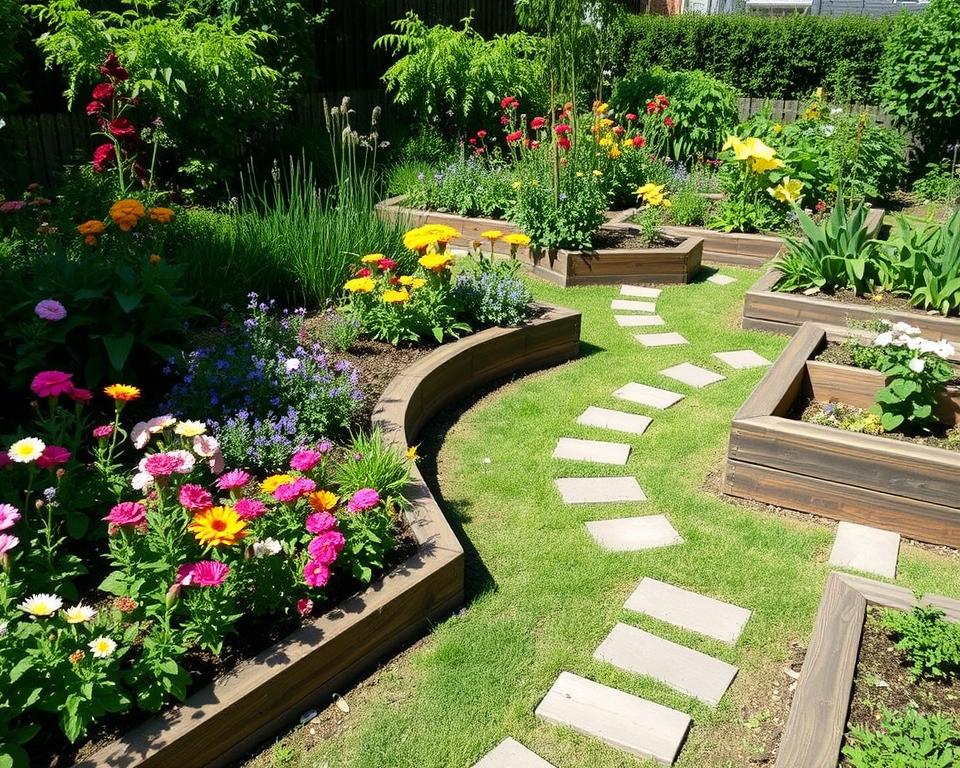
Key Takeaways
- Sleepers offer a versatile and durable solution for garden designs and landscaping projects.
- They can be used to create raised beds, retaining walls, pathways, and edging, adding visual interest and functionality to your outdoor space.
- Sleepers come in a variety of materials, including wood, concrete, and plastic, each with its own unique advantages.
- Proper preparation and installation are crucial for ensuring the longevity and aesthetic appeal of sleeper-based projects.
- Sleepers can be combined with other materials, such as stone and gravel, to create visually stunning and cohesive garden designs.
What Are Sleepers for Garden?
Sleepers, also known as railway sleepers or landscape timbers, are large, durable wooden beams. They are used in garden and landscaping projects. These sturdy elements can serve various purposes, from creating raised beds and retaining walls to defining pathways and edging. Sleepers are a popular choice for homeowners and gardeners due to their versatility and long-lasting nature.
Crafted from hardwood or softwood, sleepers for garden offer a natural and rustic aesthetic. This can enhance the overall look and feel of any outdoor space. Their robust construction makes them an ideal material for a wide range of landscaping applications, from creating visual boundaries to adding structural support for various features.
- Sleepers provide a versatile and long-lasting solution for garden projects.
- They can be used to construct raised beds, retaining walls, pathways, and more.
- Sleepers offer a natural, rustic aesthetic that complements many garden styles.
- Their durability and longevity make them a popular choice among homeowners and gardeners.
“Sleepers are a game-changer in garden design, allowing homeowners to create unique and functional outdoor spaces that stand the test of time.”
Whether you’re looking to add visual interest, define boundaries, or provide structural support, sleepers for garden can be a valuable addition to any landscaping project. Their versatility and enduring nature make them a versatile and practical choice for enhancing the beauty and functionality of your outdoor living space.
Benefits of Using Sleepers in Garden Designs
Sleepers bring many benefits to garden and landscaping projects. They are durable, long-lasting, and versatile. These qualities help transform outdoor spaces into both practical and beautiful areas.
Durability and Longevity
Sleepers are known for their exceptional durability and longevity. Made from wood, concrete, or plastic, they can handle harsh weather and heavy use. This makes them a solid choice for various garden and landscaping tasks, ensuring your investment pays off over time.
Versatility in Landscaping Projects
Sleepers are also very versatile. They can be used in many ways, from building raised beds and retaining walls to making pathways and edging. This flexibility allows for unique and attractive outdoor designs.
“Sleepers offer a durable and versatile solution that can transform any garden or landscaping project into a stunning and functional outdoor oasis.”
Looking to improve your garden’s look or its functionality? Sleepers are a great choice for many projects. They offer both beauty and practicality.
Types of Sleepers for Garden
Gardeners have many sleeper options for their projects. Each sleeper type has its own benefits and fits different needs and tastes. This lets homeowners pick the perfect sleeper for their garden.
Wood Sleepers
Wood sleepers are a timeless choice for gardens. Made from hardwoods like oak or softwoods treated with pressure, they look natural and classic. They’re easy to use and fit many garden styles.
Concrete Sleepers
Concrete sleepers are strong and easy to care for. They’re weatherproof and don’t need much upkeep. They’re great for modern gardens because they’re durable and look good.
Plastic Sleepers
Plastic sleepers are good for the environment. Made from recycled materials, they’re light, strong, and simple to put in place. They’re a green choice for many garden projects.
| Type of Sleeper | Key Benefits | Suitability |
|---|---|---|
| Wood Sleepers | Natural and timeless look Durable and long-lasting Versatile in design | Suitable for a wide range of garden projects, from raised beds to pathways. |
| Concrete Sleepers | Highly durable and weather-resistant Low maintenance Modern and functional aesthetic | Ideal for contemporary garden designs and projects requiring a sturdy, long-lasting solution. |
| Plastic Sleepers | Eco-friendly and sustainable Lightweight and easy to install Durable and weather-resistant | Suitable for gardeners seeking an environmentally conscious option for their landscaping projects. |
Choosing the right sleepers for your garden depends on several things. Think about the look you want, how long you need the sleepers to last, and your personal and environmental values. Each sleeper type has its own benefits, helping you create a beautiful and practical outdoor space that shows your style.
Preparing the Area for Sleeper Installation
When you start using sleepers in your garden, the first thing to do is prepare the area. This step is key for a good and lasting installation. You might be making a raised bed, a retaining wall, or unique pathways.
First, dig the ground and make sure it’s level. This makes a solid base for the sleepers and any extra features. It’s important for a smooth and nice-looking finish in your garden.
- Excavate the ground to the desired depth, taking into account the thickness of the sleepers and any additional layers required.
- Use a spirit level or laser level to ensure the surface is completely flat and even.
- Compact the soil or add a layer of crushed stone or gravel to create a sturdy foundation.
Getting the area ready is the secret to a sleeper installation that lasts. By spending time on preparation, your sleeper garden projects will look good and work well.
| Preparation Task | Description |
|---|---|
| Excavate Ground | Remove soil to the desired depth to accommodate the sleepers and any additional layers. |
| Level Surface | Use a spirit level or laser level to ensure the surface is completely flat and even. |
| Create Stable Base | Compact the soil or add a layer of crushed stone or gravel to provide a sturdy foundation. |
“Proper preparation is crucial for ensuring a successful and long-lasting sleeper installation, whether you’re creating a raised bed, retaining wall, or pathways.”
DIY Garden Sleeper Projects
Sleepers are great for many DIY garden projects. They’re perfect for making raised beds, retaining walls, and pathways. They add beauty and durability to your outdoor space.
Raised Garden Beds
Building raised beds with sleepers can turn your garden into a lush oasis. These beds improve soil quality and drainage. They’re perfect for growing fruits, vegetables, and herbs.
With sleepers, you can design beds that fit your gardening style. They’re sturdy and easy to customise.
Retaining Walls
Sleepers are also great for building retaining walls. These walls add beauty and function to your garden. They help manage uneven terrain and create tiered landscapes.
The natural look of sleepers is popular for a rustic feel. They’re a favourite for those who love an earthy aesthetic.
Pathways and Edging
Sleepers are versatile for pathways and edging too. They can line walkways or create borders. This adds structure and interest to your garden.
They help create a unified and beautiful garden design. Sleepers blend well with the landscape, making your garden look great.
“Sleepers offer a practical and visually striking solution for a wide range of DIY garden projects, from raised beds to retaining walls and beyond.”
Sleepers for Garden: Maintenance and Care
Keeping sleepers for garden projects in good shape is crucial. Regular checks, protective treatments, and quick fixes are key. They help keep your outdoor spaces looking great and working well.
To keep sleepers for garden in top condition, follow these tips:
- Check sleepers often for wear, damage, or colour changes.
- Use wood preservatives or sealants every few years to protect them.
- Fix any problems, like loose sleepers, right away to avoid more damage.
- Keep the area around sleepers dry, clean, and free from overgrowth.
- Replace sleepers that are badly damaged or weathered to keep your garden looking good.
By sticking to these maintenance and care tips, gardeners can make sure their sleepers for garden projects stay beautiful and functional for many years.
“The key to a long-lasting, visually appealing garden is proper maintenance and care of its essential elements, including the sleepers that form the foundation of your landscaping.”
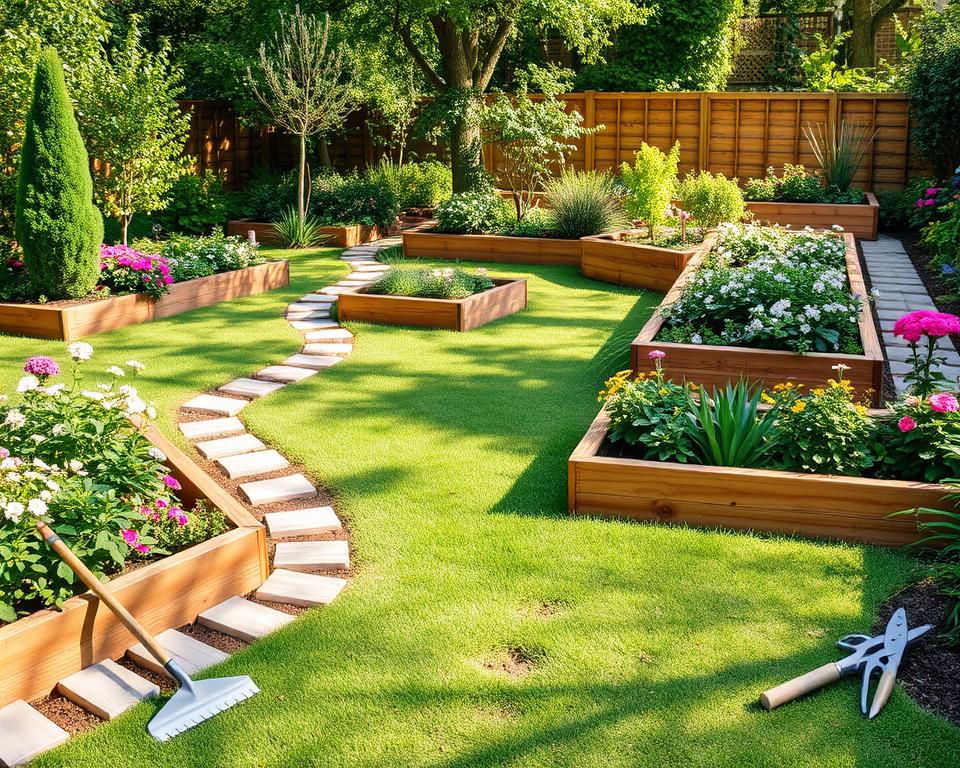
Designing with Sleepers: Inspiration and Ideas
Sleepers are versatile timber pieces that open up a world of garden design possibilities. They fit well into both modern and traditional garden styles. This makes them great for creating beautiful and useful outdoor spaces.
Contemporary Garden Designs
In modern gardens, sleepers help create a clean, modern look. Their straight edges and lines are perfect for raised beds, walls, and paths. Paired with simple plants and a calm colour scheme, they bring a sleek, easy-to-maintain vibe.
Traditional Garden Aesthetics
On the other hand, sleepers work well in traditional gardens too. They match well with stone, gravel, and cottage-style plants. The timber’s warm tones add a cozy, rustic feel. They’re great for beds, path edges, walls, or even seats, blending nature and design.
Sleepers are very flexible, allowing gardeners to match their design to their taste and garden vision. Whether you want a modern or traditional garden, sleepers provide endless ideas to enhance your outdoor space.
“Sleepers offer a unique and versatile solution for creating stunning garden designs, whether you’re going for a modern, minimalist look or a more traditional, rustic feel.”
Sleepers for Garden: Cost Considerations
When planning garden projects with sleepers for garden, cost is key. The type of sleeper, whether wood, concrete, or plastic, affects the budget. The amount needed and extra materials or labour also play a part.
To keep your sleeper for garden project within budget, compare prices. Look at what local suppliers and DIY stores offer. This way, you can choose wisely and balance looks with cost.
| Sleeper Type | Approximate Cost per Sleeper |
|---|---|
| Wood Sleepers | £15 – £25 |
| Concrete Sleepers | £20 – £35 |
| Plastic Sleepers | £10 – £20 |
The table shows a rough guide to cost considerations for sleepers for garden. But remember, prices can change based on size, quality, and where you are. The total cost also depends on your landscaping design.
“Investing in quality sleepers for garden can be a wise decision, as they offer long-lasting durability and versatility in various landscaping projects.”
Thinking about cost considerations for sleepers for garden helps gardeners. They can make beautiful and useful outdoor spaces without breaking the bank.
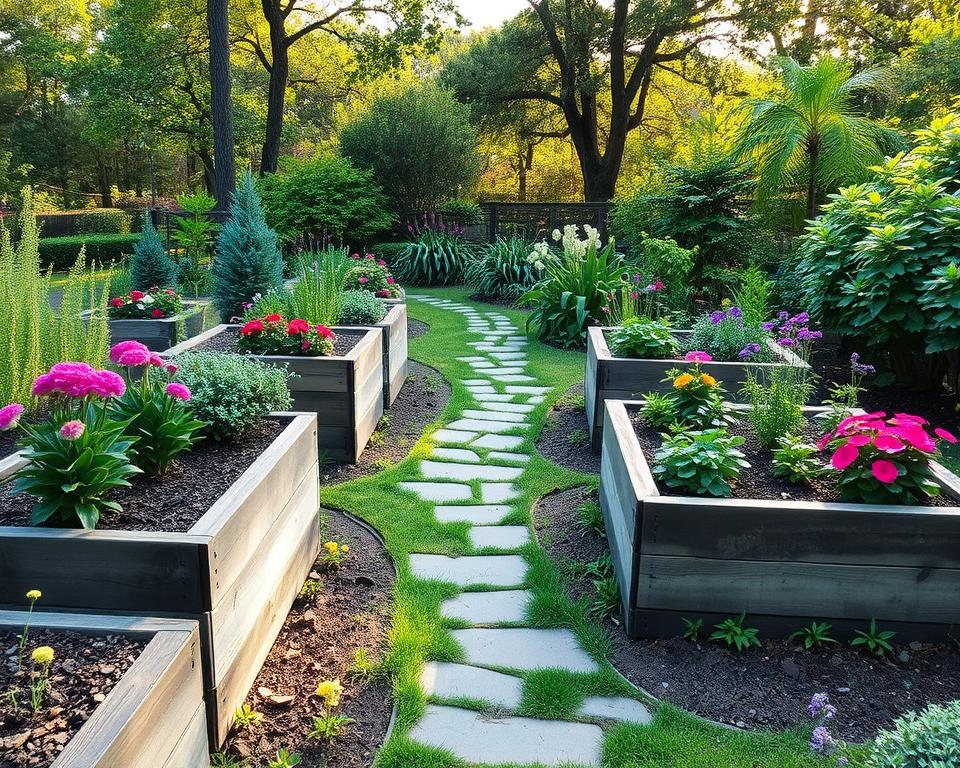
Sourcing Quality Sleepers for Your Garden Project
Getting the right sleepers is key for your garden’s success. It’s important to choose suppliers known for quality. They should offer sleepers that are durable, safe, and eco-friendly.
When picking sleepers, think about the wood’s treatment, size, and state. Well-treated sleepers can handle your garden’s needs. They provide a strong base for your outdoor designs.
Tips for Sourcing Quality Sleepers
- Look for suppliers known for quality sleepers.
- Check the sleepers yourself or ask for photos to see their condition.
- Choose sleepers treated to fight off weather and rot.
- Make sure the sleepers fit your garden project’s size needs.
- Consider the environmental impact of your choices. Opt for sustainable or recycled options.
| Sleeper Type | Recommended Source | Average Cost (per sleeper) |
|---|---|---|
| Pressure-Treated Wooden Sleepers | Specialist Timber Merchants | £20 – £40 |
| Reclaimed Wooden Sleepers | Salvage Yards or Specialist Suppliers | £15 – £30 |
| Concrete Sleepers | Landscaping or Building Supply Stores | £30 – £60 |
Choosing quality sleepers ensures your garden lasts. It makes your outdoor space look and function better.
Incorporating Sleepers into Existing Gardens
For gardeners with established outdoor spaces, adding sleepers is a great way to improve their gardens. Sleepers can enhance pathways, flower beds, or water features. They help create a cohesive and beautiful design.
To make sleepers work well in existing gardens, careful planning is key. This ensures they fit well with the garden’s look and function.
Complementing Existing Features
When adding sleepers to an existing garden, think about how they can improve what’s already there. Sleepers can make raised beds stand out or mark pathways. This creates a sense of unity and flow.
By matching the sleepers with the garden’s design, you get a stunning result. It’s all about aligning the sleepers with the garden’s elements.
Creating Cohesive Designs
Adding sleepers to a garden needs a good eye for design. Look at the garden’s colours, textures, and overall look. Choose sleepers that match or contrast well.
This way, the sleepers blend in or add interest to the garden. A cohesive design makes the garden look better and work better.
Adding sleepers to an existing garden can really change it for the better. With careful planning, sleepers can enhance the garden’s look and function.
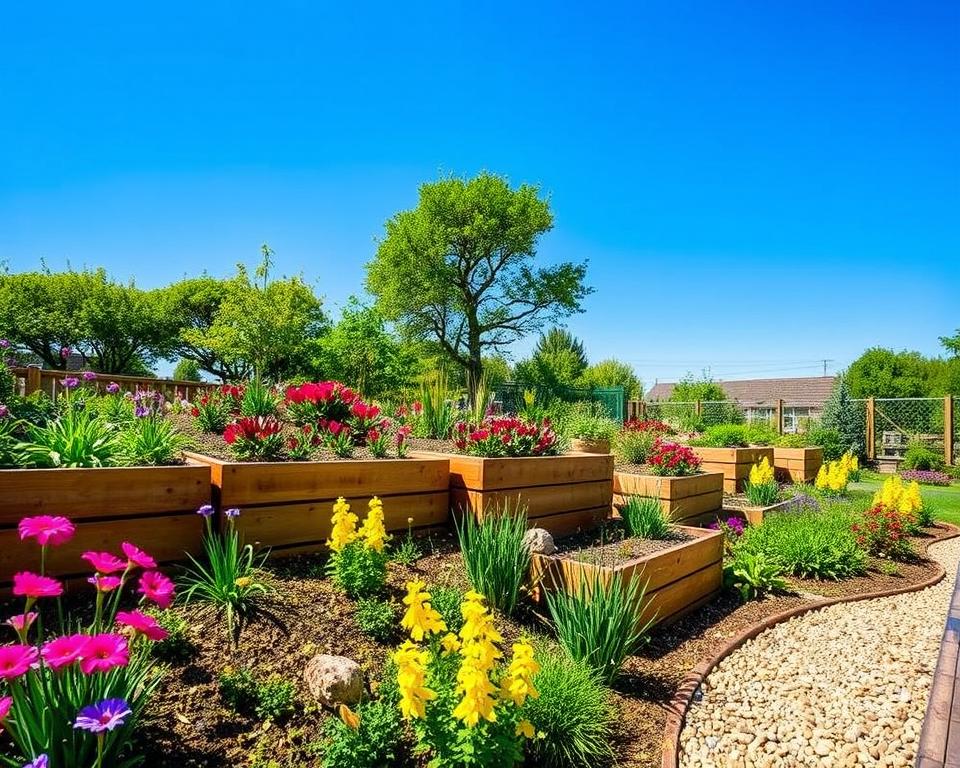
Safety Precautions for Working with Sleepers
When working on garden projects with sleepers, safety comes first. Gardeners need to take steps to ensure a safe and successful job. This protects them and their work area. Following these guidelines helps avoid risks and makes working with sleepers rewarding.
Using the right personal protective equipment (PPE) is key. This includes gloves to protect hands and safety glasses for the eyes. It’s also important to handle the sleepers carefully to avoid back injuries.
- Wear protective gloves and safety glasses
- Lift sleepers carefully to avoid injuries
- Be aware of sharp edges and potential hazards
- Work in a well-ventilated area
- Follow manufacturer’s instructions for installation
Sharp edges and splinters are common with sleepers. Always check each piece before using it. Also, work in a place with good air flow to avoid dust problems.
Following the manufacturer’s instructions is crucial. This ensures the sleepers are installed correctly and safely. It also helps prevent accidents.
By following these safety tips, gardeners can work with sleepers safely. This allows them to create beautiful outdoor spaces while keeping themselves safe.
Eco-Friendly Sleeper Alternatives
For those who care about the planet, there are green alternatives to traditional sleepers. These options make gardens more eco-friendly and show off creative garden designs.
Reclaimed or recycled timber is a great choice. It gives old wood a new life, reducing waste and adding charm to gardens.
Bamboo sleepers are another option. Bamboo grows fast and is strong. It’s a better choice than wood and makes gardens look amazing.
- Composite sleepers from recycled plastics are also popular. They’re tough, easy to care for, and good for the planet.
- Using natural stone or recycled concrete for sleepers makes gardens even greener.
Choosing eco-friendly sleepers lets gardeners beautify their spaces without harming the environment. It’s a step towards greener gardening.
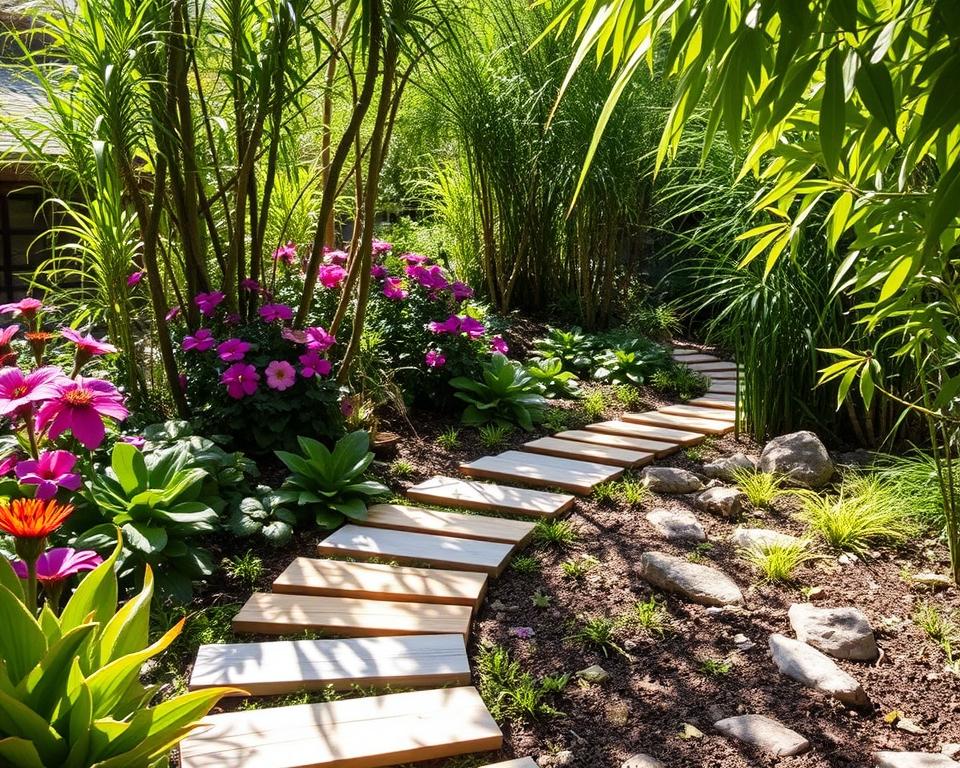
“Sustainable gardening is not just about the plants we grow, but the materials we use to create our outdoor oases. Eco-friendly sleeper alternatives offer a chance to make a positive impact while still achieving our design goals.”
Combining Sleepers with Other Materials
Sleepers are great for landscaping. They can be mixed with stone, gravel, or paving to make your garden look amazing. This mix adds depth and interest to your outdoor area.
Stone and Gravel Combinations
Using stone or gravel with sleepers looks fantastic. Sleepers can frame paths, make raised beds, or build walls. The stone or gravel fills in the gaps, making a modern and natural look.
Incorporating Plants and Greenery
Adding plants to sleeper structures softens their look. You can plant vines, shrubs, or grasses around them. This makes the sleepers blend into the garden.
Or, you can use sleepers in raised beds or planters. This lets plants spill over, making your garden lush and welcoming.
Trying different materials can lead to amazing garden designs. Sleepers are very flexible. They can be mixed with other elements to create beautiful and useful garden features. This suits many tastes and styles.
Professional Landscaping Services for Sleeper Projects
For those who like a hands-off approach or need special skills, landscaping services are great for sleeper projects. Experts can help with design, setup, and upkeep. They make sure sleepers fit well in your garden. This is especially useful for big or complex projects.
Getting help from a professional team is key for using sleepers in your garden. They know the best materials and designs. They also ensure sleepers are installed and cared for properly. This is super helpful for those new to sleepers or tackling big projects.
Landscapers also know how to keep sleeper features looking good. They can tell you the best ways to clean, seal, and fix them. This keeps your sleeper projects looking great for a long time.
| Service | Benefits |
|---|---|
| Design Consultation | Expertise in creating cohesive, visually appealing sleeper-based designs that integrate seamlessly with your garden |
| Installation | Efficient and precise installation of sleeper features, ensuring structural integrity and long-lasting results |
| Maintenance and Repair | Knowledgeable advice and services to keep your sleeper projects in top condition |
Looking to add sleepers to your garden or improve an existing area? Professional landscaping services are a big help. They ensure your sleeper projects are done right. This adds beauty and function to your outdoor space.
Troubleshooting Common Issues with Sleeper Installations
Sleepers are usually durable and easy to care for in garden projects. But, sometimes problems like warping, rotting, or instability can happen. By tackling these issues early and following care tips, gardeners can keep their landscaping looking great for years.
Warping or bending sleepers can be a problem, especially in wet or very hot areas. To avoid this, choose high-quality, treated timber or go for concrete or recycled plastic sleepers. Make sure the sleepers are installed correctly, on a level base, and securely fixed.
Rotting is another issue, especially for wooden sleepers in damp places. Check the sleepers often for decay and treat any damage with wood preservative. Using rot-resistant timber or pre-treated sleepers can also help prevent rotting.
FAQ
What are sleepers for garden?
Sleepers, also known as railway sleepers or landscape timbers, are large, durable wooden beams. They are used in garden and landscaping projects. They can be used for raised beds, retaining walls, and defining pathways and edging.
What are the benefits of using sleepers in garden designs?
Sleepers are durable and long-lasting, making them a reliable choice for gardens. They can withstand weather and heavy use. They are also versatile, fitting into many projects like raised beds and pathways, making gardens look good.
What types of sleepers are available for garden use?
There are different types of sleepers for gardens. Wood sleepers, made from hardwoods like oak, are popular. Concrete sleepers are sturdy and easy to maintain. Plastic sleepers are eco-friendly. Each type has its own benefits, helping gardeners choose the right one for their project.
How do I prepare the area for sleeper installation?
Before installing sleepers, prepare the area well. This includes digging, levelling, and making a stable base. Good preparation is key for a successful sleeper installation, whether for beds, walls, or pathways.
What are some DIY garden sleeper projects I can create?
Sleepers can be used for many DIY garden projects. They can help create raised beds, walls, pathways, and edging. They add structure and interest to outdoor spaces, helping gardeners achieve their goals.
How do I maintain and care for sleepers in my garden?
Keeping sleepers in good condition is important. Regularly check for damage and treat the wood. This helps them last longer and keeps your garden looking great.
How can I incorporate sleepers into my existing garden design?
Adding sleepers to an existing garden can enhance it. Think about how they fit with your garden’s features. With careful planning, sleepers can blend well, improving your garden’s look and feel.
What safety precautions should I take when working with sleepers?
Safety is crucial when working with sleepers. Wear protective gear and handle them carefully. Be aware of hazards like sharp edges and take steps to avoid injuries.
Are there any eco-friendly alternatives to traditional sleepers?
Yes, there are eco-friendly options like reclaimed timber and bamboo. These alternatives help reduce environmental impact. They are great for those who want to garden sustainably.





